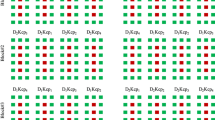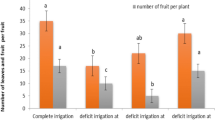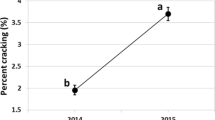Abstract
The objective of the present study was to investigate the impacts of potassium and different levels of irrigation on the yield, cracking, quality, net economical return, and water consumption of the pomegranate (Punica granatum L. -cv. Hicaznar), and was carried out at the Alata Horticultural Research Institute in 2012, 2014, and 2015 growing season in the Eastern Mediterranean region of Turkey. The main plots and subplots were set up as the potassium doses (K0: 0 g/tree; K1:300-350-400 g/tree; K2:600-650-700 g/tree) and irrigation level (I75:0.75; I100:1.00; I125:1.25). An experiment was a split-plot design with three replications for the arrangement and analyses of the aforementioned 9 treatment combinations. Irrigation was conducted when the cumulative evaporation was found to be 30 ± 5 mm. According to the experimental results, the potassium and the irrigation levels were found to profoundly affect the total pomegranate yield and yield components at a statistical error of 1% and 5%. The lowest yield was found to be at K0I75, and the highest yield was found to be at K1I125 for all 3 years. It was observed that lower irrigation levels led to lower yield. When irrigation levels were studied concerning potassium levels, the I75 level was found to produce the lowest yield. The total irrigation water for all treatments was 254–416 mm and the seasonal evapotranspiration (ET) was 387–670 mm according to the treatment. It was illustrated that potassium dose and irrigation levels significantly influenced water productivity (WP) and irrigation water productivity (IWP). The lowest level for WP was 4.77 kg m−3 at the K0I125 level, and the highest level for WP was 9.54 kg m−3 at the K1I75 level. The lowest level for IWP was 6.84 kg m−3 at the I125 level, and the highest level for IWP was 13.49 kg m−3 at the I75 level. The potassium and irrigation levels were found to affect the pomegranate yield, cracking rate, and amount of fruit, as well as parameters that represent quality, such as fruit rind thickness and amount of aril, at a statistically significant level. As a result, K1I125 levels can be recommended for a high amount of yield in the field of pomegranate cultivation with drip irrigation. The WP, IWP levels, total yield, waste yield levels, and economic net return support the use of K1I100 irrigation in conditions of drought. Over the 3-year combined economic analysis, the K1I125 treatment produced the maximum net income followed by the K1I100 treatment.


Similar content being viewed by others
Data Availability
Data availability is appropriate.
References
Adiba A, Razouk R, Charafi J, Haddioui A, Hamdani A (2021) Assessment of water stress tolerance in eleven pomegranate cultivars based on agronomic traits. Agric Water Manag 243:106419. https://doi.org/10.1016/j.agwat.2020.106419
Allen, R.G., Pereira, R.S., Raes, D., Smith, M., 1998. Crop evapotranspiration–guidelines for computing crop water requirements. FAO Irr. and Drain. Paper, No. 56, Rome.
Al-Obeed RS (2001) Effect of potassium sulfate fertilization on vegetative growth, yield, fruit quality, and leaf mineral composition of some pomegranate cultivars. Met., Env. Ari Land Agric. Sci, JKAU. https://doi.org/10.4197/met.12-1.4
Anonymous (2016) ICAR-NRCP Annual Report 2015–16. ICAR-National Research Centre on Pomegranate, Solapur, India
Ayars JE, Phene CJ, Phene RC, Gao S, Wan D, Day KR, Makus DJ (2017) Determining pomegranate water and nitrogen requirements with drip irrigation. Agric Water Manag 187:11–23. https://doi.org/10.1016/j.agwat.2017.03.007
Bakeer S (2016) Effect of ammonium nitrate fertilizer and calcium chloride foliar spray on fruit cracking and sunburn of Manfalouty pomegranate trees. Sci Hortic 209:300–308. https://doi.org/10.1016/j.scienta.2016.06.043
Bhantana, P., Lazarovitch, N., 2010. Evapotranspiration, crop coefficient and growth of two young pomegranate (Punica granatum L.) varieties under salt stress. Agric. Water Manag. 97(5): 715–722. https://doi.org/10.1016/j.agwat.2009.12.016
Blake, G.R., Hartge, K.H., 1986. Bulk density. In: Klute, A. (Ed.), Methods of Soil Analysis. Part 1. Physical and Mineralogical Methods. American Society of Agronomy Soil Science Society of America Publisher, Madison (WI), pp. 363–375. https://doi.org/10.2136/sssabookser5.1.2ed.c13.
Blumenfeld, A., Shaya, F., Hillel, R. 2000. Cultivation of pomegranate. Options Mediterraneennes, Serie A: Seminaires Mediterraneennes Numero 42: 143–147. http://om.ciheam.org/om/pdf/a42/00600264.pdf.
Burt CM, O’connor K, Ruehr T (1995) Fertigation. Irrigation Training and Research Center. California Polytechnic State Univ, San Luis Obispo, p 295
Centofanti T, Bañuelos GS, Wallis CM, Ayars JE (2017) Deficit irrigation strategies and their impact on yield and nutritional quality of pomegranate fruit. Fruits 72(1):46–53. https://doi.org/10.17660/th2017/72.1.5
Chater JM, Garner LC (2018) Foliar nutrient applications to ‘Wonderful’ pomegranate (Punica granatum L.). II. Effects on leaf nutrient status and fruit split, yield and size. Scientia Hortic 242:207–213. https://doi.org/10.1016/j.scienta.2018.07.015
Cheema GS, Bhat SS, Naik KC (1954) Commercial fruits of India, with special reference to Western India. Macmillan Co., Calcutta, India, p 442
Davarpanah S, Tehranifar A, Abadía J, Val J, Davarynejad G, Aran M, Khorassani R (2018) Foliar calcium fertilization reduces fruit cracking in pomegranate (Punica granatum cv. ardestani). Scientia Horti 230:86–91. https://doi.org/10.1016/j.scienta.2017.11.023
Dhillon, W.S., Gill, P.P.S., Singh, N.P., 2011. Effect of nitrogen, phosphorus and potassium fertilization on growth, yield and quality of pomegranate ‘Kandhari’. Acta Hortic https://doi.org/10.1760/ActaHortic.2011.890.45.
Dinc N, Aydinsakir K, Isik M, Bastug R, Ari N, Sahin A, Buyuktas D (2018) Assessment of different irrigation strategies on yield and quality characteristics of drip irrigated pomegranate under Mediterranean conditions. Irrig Sci 36:87–96. https://doi.org/10.1007/s00271-017-0565-5
El-Rahman IA (2010) Physiological studies on cracking phenomena of pomegranates. J Appl Sci Res 6:696–703
Fernandez JE, Alcon F, Diaz-Espejo A, Hernandez-Santana V, Cuevas MV (2020) Water use indicators and economic analysis for on-farm irrigation decision: a case study of a super high-density olive tree orchard. Agric Water Manag 237:106074. https://doi.org/10.1016/j.agwat.2020.106074
Fialho L, Ramoa S, Parenzan S, Guerreiro I, Catronga H, Soldado D, Guerreiro O, García VG, Silva PE, Jeronimo E (2021) Effect of regulated deficit irrigation on pomegranate fruit quality at harvest and during cold storage. Water Manag, Agric. https://doi.org/10.1016/j.agwat.2013.04.009
Galindo A, Rodriguez P, Collado-Gonzalez J, Cruz Z, Torrecillas E, Ondono S, Corell M, Moriana A, Torrecillas A (2014) Rainfall intensifies fruit peel cracking in water stressed pomegranate trees. Agric Forest Meteorol 194:29–35. https://doi.org/10.1016/j.agrformet.2014.03.015
Gill PS, Ganaie MY, Dhillon WS, Singh NP (2012) Effect of foliar sprays of potassium on fruit size and quality of ‘Patharnakh’ pear. Indian J Hort 69(4):512–516
Hamouda HA, Elham ZAM, Zahran NG (2015) Nutritional status and improving fruit quality by potassium, magnesium and manganese foliar application in pomegranate shrubs. Int J Chem Tech Res 8(6):858–867
Hoda AK, Hoda SHA (2013) Cracking and fruit quality of pomegranate (Punica granatum L.) as affected by pre-harvest sprays of some growth regulators and mineral nutrients. J Hortic Sci Ornamental Plants. https://doi.org/10.5829/idosi.jhsop.2013.5.2.1115
Holland D, Bar-Ya’akov, I., (2018) Pomegranate (Punica granatum L) breeding. In: Al-Khayri J, Jain S, Johnson D (eds) Advances in Plant Breeding Strategies: Fruits. Springer, Cham
Holland, D., Hatib, K., Bar-Yàakov, I., 2009. Pomegranate: botany, horticulture, breeding. In: Jules J (ed) Horticultural reviews, John Wiley Sons. 35:127-191 https://doi.org/10.1002/9780470593776.ch2.
Intrigliolo DS, García J, Lozoya A, Bonet L, Nicolas E, Alarcón J, Bartual J (2012) Regulated deficit irrigation in pomegranate (Punica granatum) trees. Yield and its components. Options Méditerranéennes Séries A 103:101–106
Intrigliolo DS, Bonet L, Nortes PA, Puerto H, Nicolas E, Bartual J (2013) Pomegranate tree’s performance under sustained and regulated deficit irrigation. Irrig Sci 31(5):959–970. https://doi.org/10.1007/s00271-012-0372-y
Khadivi-Khub A (2015) Physiological and genetic factors influencing fruit cracking. Acta Physiol Plant 37:1718. https://doi.org/10.1007/s11738-014-1718-2
Khattab, M.M., Shaban, A.E., El-Shrief, A.H., El-Deen, A.S., 2011. Growth and productivity of pomegranate trees under different irrigation levels. II: Fruit quality. IJHSOP 3 (3): 259–264.
Klute, A., 1986. Water retention: laboratory methods. In: Klute, A. (Ed.), Methods of Soil Analysis. I. Physical and Mineralogical Methods, second ed. American Society of Agronomy, Madison, pp. 635–662. https://doi.org/10.2136/sssabookser5.1.2ed.c26.
Laribi AL, Palou L, Intrigliolo DS, Nortes PA, Rojas-Argudo C, Taberner V, Bartual J, Pérez-Gago MB (2013) Effect of sustained and regulated deficit irrigation on fruit quality of pomegranate cv. ‘Mollar de Elche’ at harvest and during cold storage. Agric Water Manag 125:61–70. https://doi.org/10.1016/j.agwat.2013.04.009
Lester GE, Jifon JL, Makus DJ (2010) Impact of potassium nutrition on food quality of fruits and vegetables: A condensed and concise review of the literature. Better Crops 94(1):18–21
Maity A, Marathe RA, Sarkar A, Basak BB (2022) Phosphorus and potassium supplementing bio-mineral fertilizer augments soil fertility and improves fruit yield and quality of pomegranate. Scientia Hortic. https://doi.org/10.1016/j.scienta.2022.111234
Marathe RA, Babu KD, Chaudhari DT (2016) Effect of irrigation frequencies on nutrient uptake, growth and yield of pomegranate (Punica granatum) grown on heavy textured soils of semi-arid region. Indian J of Agric Sci 86(12):1559–1565
Martínez-Nicolas JJ, Galindo A, Grinan L, Rodríguez P, Cruze ZN, Martínez-Font R, Carbonell-Barrachina A, Nouri H, Melgarejo P (2019) Irrigation water saving during pomegranate flowering and fruit set period do not affect wonderful and mollar de elche cultivars yield and fruit composition. Agric Water Manag 226:1–7. https://doi.org/10.1016/j.agwat.2019.105781
Melgarejo P, Salazar DM, Artés F (2000) Organics acids and sugar composition of harvested pomegranate fruits. Euro Food Res Technol 211:185–190. https://doi.org/10.1007/s002170050021
Mellisho CD, Egea I, Galindo E, Rodríguez P, Rodríguez JB, Conejero W, Romojaro F, Torrecillas A (2012) Pomegranate (Punica granatum L.) fruit response to different deficit irrigation conditions. Agric Water Manag 114:30–36. https://doi.org/10.1016/j.agwat.2012.06.010
Meshram DT, Mittal HK, Purohit RC, Gorantiwar SD (2011) Water requirement of pomegranate (Punica granatum L.) for Solapur district of Maharashtra State. Acta Hortic 890:311–322
Meshram DT, Gorantiwar SD, Singh NV, Babu KD (2019) Response of micro-irrigation systems on growth, yield and WUE of Pomegranate (Punica granatum L.) in semi-arid regions of India. Scientia Hortic 246:686–692. https://doi.org/10.1016/j.scienta.2018.11.033
Meshram, D.T., Gorontiwar, S.D., Teixeira, J.A., Jadhav, V.T., Chandra, R., 2010. Water management in pomegranate fruit. In: R. Chandra (ed.). Vegetable and Cereal Science and Biotechnology, 4: 106–112. Fruit, Global Science Books.
Mokhtarzadeh Z, Shahsavar AR (2020) Effects of gibberellic acid, potassium nitrate and calcium sulfate on pomegranate fruit splitting and fruit characteristics. Agric Consp Sci 85(3):237–245
Nelson, D.W., Sommers, L.E., 1996. Total carbon, organic carbon, and organic matter. In: Sparks, D.L. (Ed.), Methods of Soil Analysis. Part 3. Chemical Methods, third ed. SSSA Book Ser. 5. SSSA, Madison, WI, pp. 961–1010. https://doi.org/10.2136/sssabookser5.3.c34
Ozguven, A.I., Gultekin, U., Gozlekci, S., Yılmaz, I., Yılmaz, C., Kucuk, E., Imrak, B., Korkmaz, C., 2015. A review of the economics and the marketing of the pomegranate industry in Turkey. Acta Hortic. 1089: 221–228. https://doi.org/10.17660/ActaHortic.2015.1089.27.Pal, R.K., Singh, N.V., Maity, A., 2017. Pomegranate fruit cracking in dryland farming. Current Sci. 112 (5): 896–897.
Parvizi H, Sepaskhah AR (2015) Effect of drip irrigation and fertilizer regimes on fruit quality of a pomegranate (Punica granatum L. cv. Rabab) orchard. Agric Water Manag 156:70–78. https://doi.org/10.1016/j.agwat.2015.04.002
Parvizi H, Sepaskhah AR, Ahmadi SH (2014) Effect of drip irrigation and fertilizer regimes on fruit yields and water productivity of a pomegranate (Punica granatum L. cv Rabab) orchard. Agric Water Manag 146:45–56. https://doi.org/10.1016/j.agwat.2014.07.005
Parvizi H, Sepaskhah AR, Ahmadi SH (2016) Physiological and growth responses of pomegranate tree (Punica granatum L. cv. Rabab) under partial root zone drying and deficit irrigation regimes. Agric Water Manage 163:146–158. https://doi.org/10.1016/j.agwat.2015.09.019
Passafiume R, Perrone A, Sortino G, Gianguzzi G, Saletta F, Gentile C, Farina V (2019) Chemical–physical characteristics, polyphenolic content, and total antioxidant activity of three Italian-grown pomegranate cultivars. NFS Journal 16:9–14. https://doi.org/10.1016/j.nfs.2019.06.001
Phene, C.J., McCormick, R.L., Davis, K.R., Pierro, J., Meek, D.W., 1989. A lysimeter feedback irrigation controller system for evapotranspiration measurements and real time irrigation scheduling. Trans. of the ASAE 32 (2): 477–484. https://doi.org/10.13031/2013.31029.
Pienaar, L., 2021. The economic contribution of South Africa’s pomegranate industry. www.elsenburg.com, www.sapomegranete.co.za.
Rodríguez P, Mellisho CD, Conejero W, Cruz ZN, Ortuno MF, Galindo A, Torrecillas A (2012) Plant water relations of leaves of pomegranate trees under different irrigation conditions. Environ Exp Bot 77:19–24. https://doi.org/10.1016/j.envexpbot.2011.08.018
Saad FA, Shaheen MA, Tawfik HA (1988) Anatomical study of cracking in pomegranate fruit. Alex J Agric Res 33(1):155–166
Saei H, Sharifani MM, Dehghanic A, Esmaeil S, Vahid A (2014) Description of biomechanical forces and physiological parameters of fruit cracking in pomegranate. Scientia Hortic 178:224–230. https://doi.org/10.1016/j.scienta.2014.09.005
Seidhom, S.H., El-Rahman, G., 2011. Prediction of traditional climatic changes effect on pomegranate trees under desert conditions in El-Maghara, Egypt. Am. J. Sci. 7 (5): 268–280. https://doi.org/10.21608/sjas.2019.18437.1005.
Selahvarzi Y, Zamani Z, Fatahi R, Talaei AR (2017) Effect of deficit irrigation on flowering and fruit properties of pomegranate (Punica granatum cv. Shahvar). Agric Water Manag 192:189–197. https://doi.org/10.1016/j.agwat.2017.07.007
Sezen SM, Yucel S, Tekin S, Yıldız M (2019) Determination of optimum irrigation and effect of deficit irrigation strategies on yield and disease rate of peanut irrigated with drip system in Eastern mediterranean. Agric Water Manag 221:211–219. https://doi.org/10.1016/j.agwat.2019.04.033
Sheikh, M., Manjula, N., 2006. Effect of chemicals on control of fruit cracking in pomegranate (Punica granatum L.) var. Ganesh. ISHS, 1st Int. Symp., Pomegranate and Minor Mediterranean Fruits, Adana, Turkey.
Singh A, Shukla AK, Meghwal PR (2020) Fruit cracking in pomegranate: extent, cause, and management - A review. Int J of Fruit Sci 20(3):1234–1253. https://doi.org/10.1080/15538362.2020.1784074
Snedecor, G.W., Cochran, W.G., 1989. Statistical methods (8th ed.), Iowa State University Press, Ames, IA, USA,503 p.
TUIK, 2022. Turkish Statistical Institute, Ankara, Turkey, www.tuik.gov.tr.
USDA (1954) Salinity laboratory staff. diagnosis and important of saline and alkali soils. Hand Book, Washington, DC, USA, No 60:25–37
USSL, 1954. Diagnosis and improvement saline and alkali soils. Agriculture Handbook, 60, U.S. Salinity Lab. Staff, USA, 160 p. https://doi.org/10.2136/sssaj1954.03615995001800030032x
Volschenk, T., 2020. Water use and irrigation management of pomegranate trees - A review. Agric. Water Manag. 241 (1): 106375 (14p). https://doi.org/10.1016/j.agwat.2020.106375.
Yılmaz, C., Ozguven, A.I., 2019. Physiology of preharvest fruit cracking in pomegranate: mineral contents. Acta Hortic. 1254: 205–212. https://doi.org/10.17660/ActaHortic.2019.1254.31.
Yılmaz, H., Dervis, O, Ertas, M.R., Yıldız, A., 1995. The effects of irrigation levels on growth, yield and quality of pomegranate in drip and surface irrigation conditions. Turkey II. National Hort. Sci. Cong., October 03–07, 1995, Adana 1 672–676.
Zhang H, Wang D, Ayars JE, Phene CJ (2017) Biophysical response of young pomegranate trees to surface and sub-surface drip irrigation and deficit irrigation. Irrig Sci 35(5):425–435
Acknowledgements
The authors are grateful to the General Directorate of Agricultural Research and Policies (TAGEM) for providing financial support to carry out the present study under Project No. TSKAD/14/A13/P02/06.
Author information
Authors and Affiliations
Contributions
Author contributions section All authors contributed to the study’s conception and experimental design. Material preparation, data collection, analysis, and designed the figures and tables were performed by B.I., S.M.S., C.Y. and M.U.. All authors provided critical feedback and helped shape the research, analysis, and manuscript, and also approved the final manuscript.
Corresponding author
Ethics declarations
Conflict of interest
The authors declare that they have no known competing financial interests or personal relationships that could have appeared to influence the work reported in this paper.
Additional information
Publisher's Note
Springer Nature remains neutral with regard to jurisdictional claims in published maps and institutional affiliations.
Rights and permissions
Springer Nature or its licensor (e.g. a society or other partner) holds exclusive rights to this article under a publishing agreement with the author(s) or other rightsholder(s); author self-archiving of the accepted manuscript version of this article is solely governed by the terms of such publishing agreement and applicable law.
About this article
Cite this article
Iscimen, B., Sezen, S.M., Yılmaz, C. et al. Combined impacts of different irrigation levels and potassium doses on drip-irrigated pomegranate yield, quality, water productivity, cracking rate, and the economic net return. Irrig Sci 41, 629–648 (2023). https://doi.org/10.1007/s00271-023-00860-z
Received:
Accepted:
Published:
Issue Date:
DOI: https://doi.org/10.1007/s00271-023-00860-z




